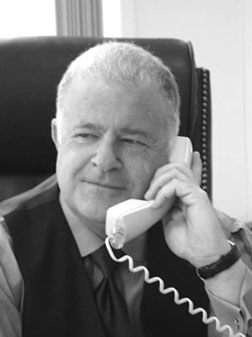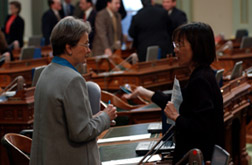If Neil Armstrong were asked to speak about the California Legislature’s recent passage of Senate Bill (SB) 916 (D-Perata, Oakland), he might say that it will create one small wave for ferries, one tsunami of funding for Bay Area commuters.

Published: October, 2003
If Neil Armstrong were asked to speak about the California Legislature’s recent passage of Senate Bill (SB) 916 (D-Perata, Oakland), he might say that it will create one small wave for ferries, one tsunami of funding for Bay Area commuters. If signed by the governor, this bill will allow voters in seven Bay Area counties to approve a $3 billion spending plan for approximately 35 regional transit projects, including rail, bus, BART, bike, ferry and Translink, by raising state-owned bridge tolls by one dollar, from $2 to $3. A second bill, SB 915, gives the San Francisco Bay Area Water Transit Authority (WTA) the green light to develop seven new Bay Area ferry routes, expand existing ferry routes, and build 31 new boats. Some new ferry services could start running as early as 2007.
Expanding the Ferry System
"The WTA’s plan shows that our region’s public transit service can be enhanced with convenient, cost-effective ferry service. As the operators of this expanded system, we are ready to start working with Bay Area communities to build boats and new terminals," said the WTA’s CEO, Thomas G. Bertken. The State of California created the WTA in 2000 to plan the expansion of water transit service through extensive technical studies and public input.
Charlene Haught Johnson, president of the WTA’s Board of Directors added, "We couldn’t have gotten this far without the invaluable input from ferry and other transit operators and advocates, elected officials, government agencies, business people, environmentalists, and many others who helped us develop this plan. We are very grateful to these dedicated souls who attended countless public meetings. Together, we designed a ferry system to meet the unique needs of Bay Area commuters."
The WTA’s ten-year plan recommends new ferry routes to Berkeley, Richmond, Treasure Island, Antioch-Martinez, Hercules, South San Francisco and Redwood City, and expansion of existing routes. These routes were chosen based on ridership projections. The WTA will also study a route between the East Bay and the Peninsula, Port Sonoma, and several future locations including Hunter’s Point and Moffett Field.
SB 915 will promote environmentally-friendly public transit and sets new standards for the nation’s ferry industry. The WTA will use boats with advanced emissions controls that will result in air emissions 85 percent cleaner than EPA’s 2007 standards for diesel engines. At least one boat will run on biodiesel, a renewable fuel made from soybeans, recycled grease, or animal fat. Looking to the future, the WTA already has received a federal grant to design a zero-emission fuel-cell ferry that would likely serve Treasure Island.
Bridge Toll Funding Aims to Integrate Transit
Senator Don Perata, the author of both bills, said, "We have to recognize that we’re not talking exclusively about ferries. This is an integrated expenditure plan that as BART gets stronger, as AC Transit can put more buses across the Bay and we can use HOV lanes to their God-intended purposes, if we can make the ACE trains stronger so the service coming into the southern part of the Bay is enhanced, we are integrating the whole system, we are making everything stronger. Without that kind of a broad coalition, this isn’t going to work."
Among other vital Bay Area transit projects, SB 916 would provide funding for part of the proposed ferry system. Specifically, it includes funding for two out of the seven new proposed ferry routes: Berkeley and South San Francisco, plus two additional boats for Oakland/Alameda. Voters in seven Bay Area counties will have a chance to approve the transit-spending plan in March 2004 by a majority. The WTA will work with local cities in pursuing federal and local funding for the services that did not get funded in SB 916. Sources of additional funding include local sales tax measures and the Federal Ferryboat Discretionary Fund. Total ten-year cost of the full ferry system plan is $646 million.
San Francisco County Transportation Authority Commission President and Board of Supervisors member Chris Daly said, "This spending plan jump-starts transit projects throughout the Bay Area and its passage is very important for San Francisco. It will fund the Transbay Terminal, MUNI Metro East/3rd Street corridor and expansion of the MUNI historic streetcar in the Embarcadero as well as ferries. The funds for water transit help continue the revitalization of the area next to the Ferry Building by providing more docks and passenger improvements. Ferries might also come in handy should the bridges or BART tube be disabled due to earthquake or other unexpected event."
Linda Perry, a member of Friends of the Berkeley Ferry, has been advocating ferry service for Berkeley for over 20 years. Upon learning about the passage of SB 916 and 915, Ms. Perry said, "We knew it had to happen because ferries are such an obvious way to cross the SF Bay. This is something to rally behind. People who’ve been yearning for water transit in their community now have renewed hope."
Both bills await the governor’s signature; he has until October 12 to either sign the bill, veto it, or simply allow it to become law without any action.



